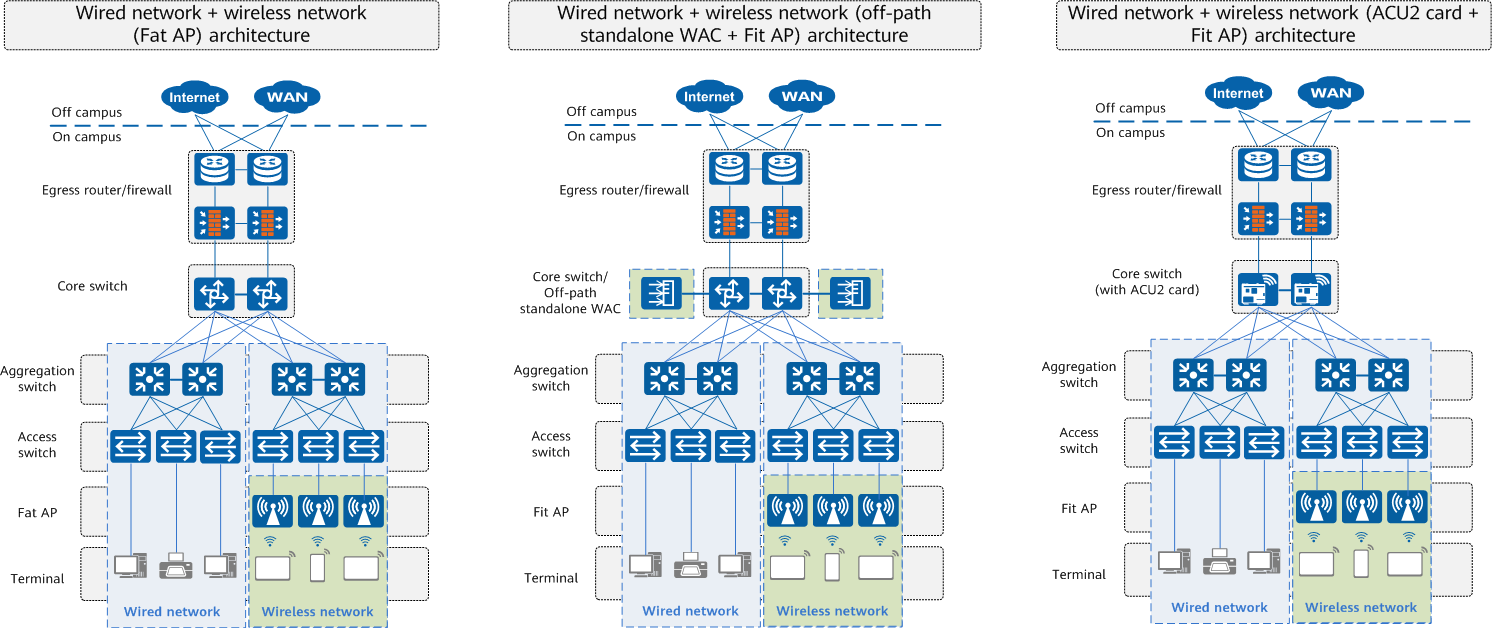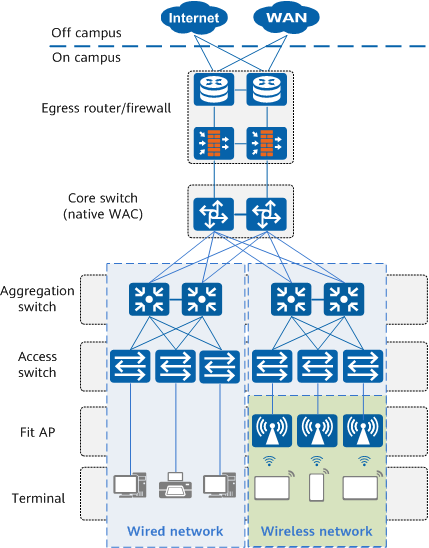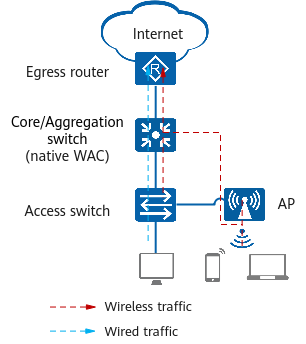What Is Wired and Wireless Convergence?
Wi-Fi networks were initially used as an extension and supplement to wired networks. Due to the fast rise of wireless networks, however, many organizations now have started to deploy fully-wireless campus networks at scale. This obviously signifies that wireless networks change from a "supporting role" to a "leading role". In either standalone wireless access controller (WAC) or WAC card solutions, wireless traffic and wired traffic are completely separate, leading to separate network management, traffic forwarding, fault locating, access authentication, and access policy implementation for wired and wireless users. This invariably results in difficult maintenance and management. To change this, industry vendors start to launch wired and wireless convergence solutions to implement unified forwarding and management of wired and wireless networks.
Why Do We Need Wired and Wireless Convergence?
In traditional "wired network + wireless network" deployment of campuses, three wireless network architectures are mainly used: Fat AP architecture, off-path standalone WAC + Fit AP architecture, as well as ACU2 card + Fit AP architecture, as shown in the following figure.

Traditional wired and wireless network deployment
Architecture 1: Wired network + wireless network (Fat AP)
Fat APs are directly connected to access switches. The Fat APs can emit radio signals, through which wireless terminals can access the network. The Fat APs are also responsible for wireless service configuration and management. In fact, Fat APs can not only emit radio signals, but also independently implement management and control functions such as security encryption, user authentication, and user management. Each Fat AP, however, is independent and autonomous, without any centralized management and control device. Therefore, it is difficult to manage these Fat APs.
Architecture 2: Wired network + wireless network (off-path standalone WAC + Fit AP)
To facilitate centralized management and control, mainstream vendors in the industry propose the "WAC + Fit AP" architecture. This new architecture introduces two new types of devices, namely, WAC and Fit AP, to replace the original Fat AP. Fit APs provide fewer functions than Fat APs, as they provide only radio signals but not management and control functions. Their management and control functions are migrated onto a standalone WAC. Specifically, the WAC uses the Control And Provisioning of Wireless Access Points (CAPWAP) protocol to centrally configure and manage all Fit APs. In this way, the basic functions of wireless networks are implemented using the WAC plus Fit APs. In most cases, the WAC is connected to a core or an aggregation switch in off-path mode. The WAC can also be deployed directly between Fit APs and the core or aggregation switch. Fit APs are typically connected to access switches.
Architecture 3: Wired network + wireless network (ACU2 card + Fit AP)
Wired and wireless networks are gradually integrated by using WAC cards. However, this is far from reaching the true convergence of wired and wireless networks. Although wired and wireless networks are seemingly integrated, wired and wireless data traffic are still processed separately. Specifically, wired traffic is processed by the switch, whereas wireless traffic is handled by the ACU2 card on the switch. Wired and wireless integration means that the switch processing wired services and the WAC processing wireless services are integrated into one device for unified management. Huawei's ACU2 card solution is an example of wired and wireless integration. The ACU2 card is a value-added service card installed on a switch and can process wireless services. By installing such a card, a wireless network can be overlaid on the wired network to provide wireless access capabilities. This implements wired and wireless integration and simplifies device management to some extent.
To sum up, in either standalone WAC or WAC card solutions, wireless traffic and wired traffic are completely separate, leading to separate network management, traffic forwarding, fault locating, access authentication, and access policy implementation for wired and wireless users. This invariably results in difficult maintenance and management. To change this, industry vendors start to launch wired and wireless convergence solutions to implement unified forwarding and management of wired and wireless networks.
At Huawei, we develop a native WAC solution to truly implement wired and wireless convergence. The Huawei solution no longer uses a standalone WAC or an ACU2 card. Instead, a switch has integrated with the WAC capability. In this way, the switch not only processes wired packets, but also identifies and processes CAPWAP packets, truly implementing wired and wireless convergence.
Network Architecture of Wired and Wireless Convergence
Seen from this topology, wired and wireless service traffic are centrally managed by switches, and wired and wireless services are uniformly configured and managed on switches. In this way, wired and wireless networks are truly converged. The end results include greatly simplified management and reduced network deployment costs.

Network architecture of wired and wireless convergence
How Does Wired and Wireless Convergence Work?
A switch integrated with the WAC function is also called native WAC. Through this single switch, the network provides centralized management, authentication, and policy control for both wired and wireless services, truly implementing wired and wireless convergence.
The native WAC can identify wireless packets, encapsulate the packets with a CAPWAP header, and decapsulate CAPWAP packets. The switch processes all packets and takes the same forwarding action on wired and wireless packets. In this way, wireless traffic does not need to be sent to a WAC and then back to the switch, eliminating forwarding bottlenecks on the wireless network.
With the native WAC, the wireless traffic forwarding capability has been significantly enhanced to Tbit/s-level. Customers do not need to purchase standalone WACs or WAC cards, which reduces costs as well as failure points. On a campus network, one switch can provide WAC functions and converge the forwarding, control, and management planes. The convergence at the network element (NE) level solves the problem of separate traffic control and forwarding for wired and wireless networks. In addition, the high switching capability and scalability of the switch eliminate the bottleneck in centralized traffic forwarding on standalone WACs or WAC cards.

Traffic paths with the native WAC deployed
- Author: Tang Jinhua
- Updated on: 2023-09-05
- Views: 1508
- Average rating:







